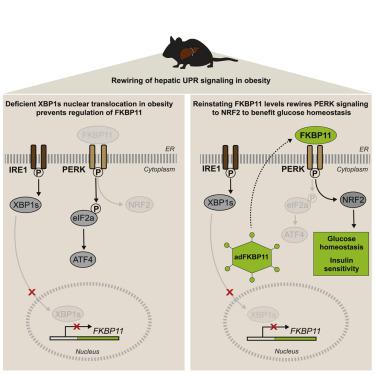Cell Metabolism ( IF 29.0 ) Pub Date : 2022-07-05 , DOI: 10.1016/j.cmet.2022.06.007 Hilde Herrema 1 , Dongxian Guan 1 , Jae Won Choi 1 , Xudong Feng 1 , Mario Andres Salazar Hernandez 1 , Farhana Faruk 1 , Thomas Auen 1 , Eliza Boudett 1 , Rongya Tao 1 , Hyonho Chun 2 , Umut Ozcan 1

|
Chronic endoplasmic reticulum (ER) stress and sustained activation of unfolded protein response (UPR) signaling contribute to the development of type 2 diabetes in obesity. UPR signaling is a complex signaling pathway, which is still being explored in many different cellular processes. Here, we demonstrate that FK506-binding protein 11 (FKBP11), which is transcriptionally regulated by XBP1s, is severely reduced in the livers of obese mice. Restoring hepatic FKBP11 expression in obese mice initiates an atypical UPR signaling pathway marked by rewiring of PERK signaling toward NRF2, away from the eIF2α-ATF4 axis of the UPR. This alteration in UPR signaling establishes glucose homeostasis without changing hepatic ER stress, food consumption, or body weight. We conclude that ER stress during obesity can be beneficially rewired to promote glucose homeostasis. These findings may uncover possible new avenues in the development of novel approaches to treat diseases marked by ER stress.
中文翻译:

FKBP11 重新连接 UPR 信号以促进 2 型糖尿病和肥胖症的葡萄糖稳态
慢性内质网 (ER) 应激和未折叠蛋白反应 (UPR) 信号的持续激活有助于肥胖中 2 型糖尿病的发展。UPR 信号是一个复杂的信号通路,在许多不同的细胞过程中仍在探索。在这里,我们证明了由 XBP1s 转录调节的 FK506 结合蛋白 11 (FKBP11) 在肥胖小鼠的肝脏中严重减少。在肥胖小鼠中恢复肝脏 FKBP11 表达会启动一种非典型的 UPR 信号通路,其标志是 PERK 信号向 NRF2 重新布线,远离 UPR 的 eIF2α-ATF4 轴。UPR 信号的这种改变在不改变肝脏 ER 压力、食物消耗或体重的情况下建立了葡萄糖稳态。我们得出结论,肥胖期间的 ER 压力可以有益地重新连接以促进葡萄糖稳态。这些发现可能会为开发治疗以 ER 应激为特征的疾病的新方法开辟可能的新途径。

























 京公网安备 11010802027423号
京公网安备 11010802027423号